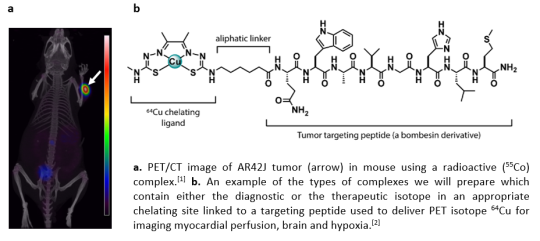Vejleder: Christine McKenzie
Projektbeskrivelse
We aim to invent enabling technology for implementing radioactive antimony and cobalt isotopes (119Sb or 58mCo) with decay properties superior to those used currently in the clinic for radiopharmaceutical cancer therapy, but which are as yet unexploited. With their short range of radioactive decay, new radiopharmaceuticals based on these isotopes are predicted to minimize damage to surrounding healthy tissue. Incredibly fortuitously, sister isotopes 117Sb or 55Co will allow concurrent monitoring of treatment progress using PET/SPECT-CT scanners. This means the same transporter molecules can be used for different isotopes of the same element.
Using our knowledge of bioinorganic chemistry, we are designing and synthesizing new biocompatible transporter molecules which will be essential for the administration of 119Sb and 58mCo to patients. Work involves synthesis, spectroscopy, analytical chemistry and X-ray diffraction in the design and syntheses of promising “cold” Co and Sb complexes. Promising candidates will be optimized for rapidity to set the stage for preparing their “hot” counterparts and testing uptake into cancer cell lines.
This work is a collaboration with Assoc. Prof. Helge Thisgaard[1] of the Nuclear Medicine department at OUH.

[1] H. Thisgaard, et al., Highly Effective Auger-Electron Therapy in an Orthotopic Glioblastoma Xenograft Model using Convection-Enhanced Delivery. Theranostics, 2016. 6, 2278-2291; J. H. Dam, et al., A PSMA Ligand Labelled with Cobalt-55 for PET Imaging of Prostate Cancer. Mol Imaging Biol, 2017, 19, 915-922.
[2] B. M. Paterson and P. S. Donnelly, Copper complexes of bis(thiosemicarbazones): from chemotherapeutics to diagnostic and therapeutic radiopharmaceuticals, Chem. Soc. Rev ., 2011, 40, 3005–3018